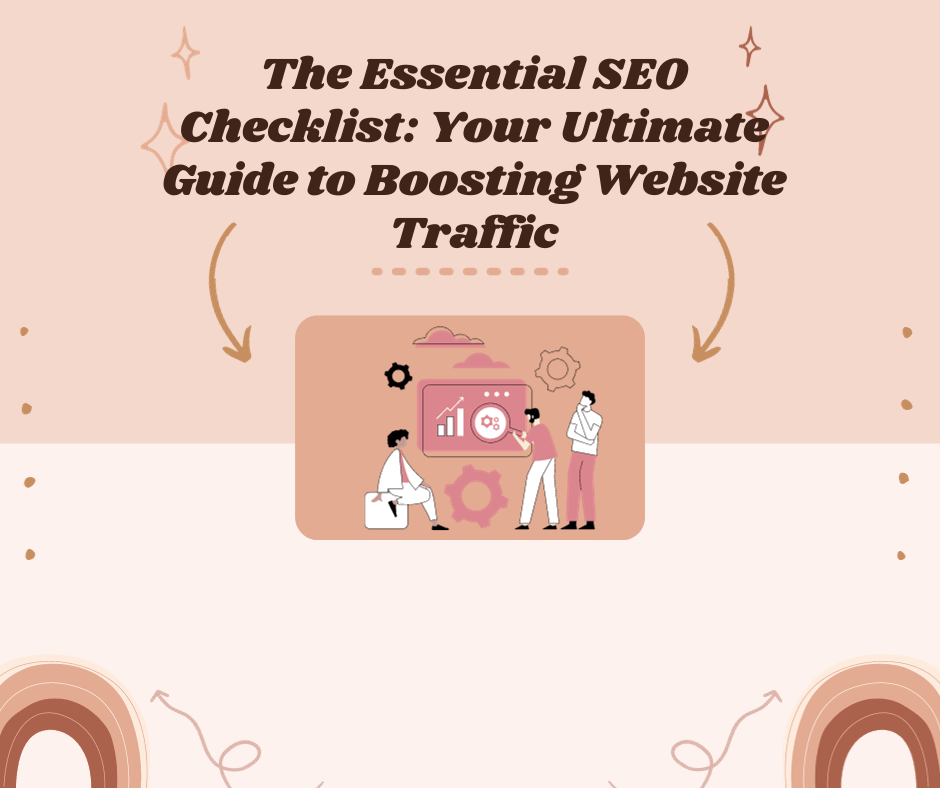The Essential SEO Checklist: Your Ultimate Guide to Boosting Website Traffic

January 16, 2024
356
- Conduct Keyword Research:
Start by identifying relevant keywords and phrases that align with your website’s content. Use keyword research tools like Google Keyword Planner, SEMrush, or Moz to find the most searched-for terms in your niche. Aim for keywords with high search volume and low competition to increase your chances of ranking higher in search results.
- Optimize Website Structure:
Ensure your website is user-friendly and easy to navigate by organizing your content into logical categories and creating a clear site structure. Use descriptive and SEO-friendly URLs, add breadcrumbs, and optimize your website’s internal linking structure to improve user experience and search engine crawlers’ ability to understand your site.
- Optimize Page Titles and Meta Descriptions:
Craft compelling and keyword-rich page titles and meta descriptions for each page on your website. These elements appear as snippets in search engine results and play a crucial role in attracting users to click on your site. Make sure they accurately describe the content and entice users to visit your website.
- Create Engaging and High-Quality Content:
Produce well-researched, informative, and engaging content that satisfies the needs of your target audience. Use a mix of text, images, videos, and other multimedia elements to make your content more appealing. Incorporate relevant keywords naturally within your content to improve its visibility in search engine rankings.
- Optimize Images and Media:
Optimize your images by compressing them without compromising quality and adding descriptive alt tags. This step helps search engines understand what your images represent, making them more likely to appear in image search results and improving overall SEO.
- Improve Website Loading Speed:
Page loading speed is crucial for both user experience and SEO. Use tools like Google PageSpeed Insights or GTmetrix to analyze your website’s loading speed and identify areas for improvement. Optimize images, minify CSS and JavaScript files, enable browser caching, and choose a fast and reliable hosting provider to enhance your site’s loading time.
- Build High-Quality Backlinks:
Backlinks from reputable and authoritative websites can significantly boost your website’s SEO. Reach out to industry influencers and bloggers to collaborate on guest posts or interview opportunities. Engage with your community and encourage them to share your content, increasing the likelihood of attracting backlinks.
- Optimize for Mobile Devices:
Given the rise in mobile internet usage, it is essential to have a responsive and mobile-friendly website. Ensure your website design is optimized for various screen sizes and devices, providing an optimal browsing experience for all users. Google also prioritizes mobile-friendly websites in its search results, making this optimization step crucial.
- Utilize Social Media for Promotion:
Leverage social media platforms to promote your content and drive more traffic to your website. Share your blog posts, engage with your followers, and participate in relevant communities. Social signals from platforms like Facebook, Twitter, and LinkedIn can indirectly impact your SEO rankings.
- Monitor and Analyze Performance:
Regularly monitor and analyze your website’s performance using tools like Google Analytics and Google Search Console. Track metrics such as organic traffic, bounce rate, time-on-site, and keyword rankings. Use these insights to identify areas for improvement and adjust your SEO strategy accordingly.
Conclusion:
By following this essential SEO checklist, you’ll be well-equipped to boost your website traffic. Remember, SEO is an ongoing process, so consistently implement these strategies and monitor your website’s performance to ensure long-term success. With dedication and persistence, you’ll see a steady increase in organic traffic, leading to more visibility, engagement, and ultimately, the growth of your online presence.
Recommended Posts

SEO-Friendly Web Design
March 7, 2025

Running Successful Social Media Ads
February 26, 2025

How To Spot A Good SEO Agency
February 24, 2025

